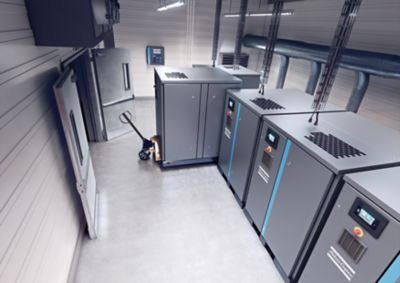Compressed air use: putting safety first and the legal requirements
by Steve Matthews, QSHE Manager UK & Ireland, Atlas Copco
In this article Steve Matthews looks at the potential hazards involved in compressed air use and asks how aware is industrial management of the preventative measures that can be taken, the scope of current pressure regulations and the legal obligations of compliance. He outlines the safety responsibilities of the equipment manufacturer and all involved in the supply chain and examines whether the picture has changed from the past to mitigate any of these risk factors.
Reading time: 9 minutes (1595 words)
As a vital contributor to productivity in the manufacturing and industrial landscape, compressed air is as essential to many process operations as electrical energy. However, the misuse of either utility in the workplace can pose a threat of serious or even fatal consequences. From the compressed air user perspective, poorly designed and installed equipment, lack of hazard awareness, neglect of regulations and disregard of safety procedures all contribute to potential risk to people, productivity and profit.
Since when was air dangerous?
According to some statistics, each year in Great Britain there are on average 150 dangerous occurrences of which about six result in fatal or serious injury. Direct contact with compressed air can lead to serious medical conditions. The accidental release of high pressure air, resulting from equipment failure, or the use of air supply equipment in the wrong, untrained or unaware hands, can have potentially fatal consequences. There are a number of serious air hazard scenarios that apply throughout industry, often the result of the misuse of blowguns. For instance, as little as 1 bar(g) of compressed air pressure can blow an eye out of its socket. Compressed air can also enter the bloodstream through the skin and, if it makes its way to blood vessels and the heart, create symptoms similar to a heart attack. Furthermore, an air pocket reaching the brain can lead to a stroke or prove fatal. Additionally, if compressed air is accidentally blown into the mouth it can rupture the lungs, stomach, and intestines. Even at a pressure as low as 0.25 bar(g), air entering the navel, even through a layer of clothing, can also inflate and rupture the intestines. Just as dangerous, a 3 bar(g) air stream in the vicinity of the eardrum can cause a brain haemorrhage.
Safety training and responsibility with compressed air installations
While the appropriate level of operator supervision is an obvious remedy to mitigate unnecessary risk, all of these personally hazardous situations in the workplace can be prevented by a combination of correct installation, appropriate safety training, regular planned maintenance and monitoring schedules to ensure equipment is in the optimum operational condition. Although it can be argued that end-user management should be responsible for operator safety training, there is an implicit obligation of responsibility within the manufacturer’s supply chain and service management to take the initiative for implementation of these measures.
Air compressor maintenance and system audits
Compressed air systems: the legal requirements
What has to be emphasised is that many compressed air users may not fully realise that the operation of a compressed air system is subject to legal requirements. In its advisory role, BCAS, the UK’s trade and technical association, makes it clear that the user of installed compressed air plant or the owner of mobile compressor equipment is subject to the legal requirements of the Pressure Systems Safety Regulations S.I. 2000 No 168 (PSSR), a statutory instrument for the ‘in-service’ use of pressure equipment.
The British Compressed Air Society is a good place to start if you are checking your legal obligations with compressed air systems.
What else can be done to improve safety with air compressor systems?
It is true to say that despite the best efforts of equipment suppliers, the official guidance and the stringent legal requirements that are in place, there remains concern that there are still too many cases of compressed air systems being operated without consideration of regulations, a disregard that is not only dangerous but clearly illegal. Unfortunately, realisation of the need for compliance sometimes results after a safety event and the harsh reality of an insurance claim. Hopefully, more users will realise that focussing on safety can positively impact on productivity and profitability. In keeping with this, companies are advised to partner with compressed air equipment manufacturers who have integrated a QSHE culture within their own processes, from product development to manufacturing to field service.
Pressure Systems Safety Regulations 2000 (PSSR) - Your obligations
As a duty of care Atlas Copco would like to bring to your attention that in accordance with the Pressure Systems Safety Regulations 2000, it is a legal requirement that a Written Scheme of Examination (WSE) is in place on most pressure systems before the equipment is put into operation. It also states that if any changes or amendments are made to the pressure system, the WSE must also be updated accordingly by a competent person. This statutory obligation sits with the user/owner of the equipment and is regulated by the Health and Safety Executive. Failure to comply with these regulations could result in fines or prosecution. To support our customers, Atlas Copco has partnered with a trusted specialist in this area, Mandate Systems, who can assist with providing further clarification on the regulations and what steps you need to undertake to legally comply. To request more information, please complete the online form by clicking here and a specialist from Mandate Systems will be in touch shortly. Or alternatively, you can contact them by calling 01274 691091, emailing atlascopco@mandatesystems.com or visit www.mandatesystems.com.
Get the latest news and stories from Atlas Copco straight to your inbox Subscribe to our monthly Fresh Air newsletter

